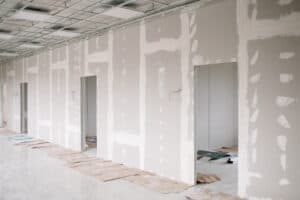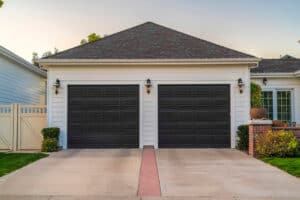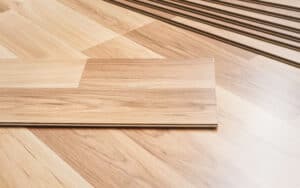
Many homeowners treat vapor barriers, or vapor retarders, as a side thought, but vapor barriers play an integral role in the water-resistant capabilities of your home.
However, will tar paper make a proper vapor retarder for your home?
Learn everything to know about tar paper in our comprehensive guide on vapor barriers and using tar paper compared to other materials.
Can Tar Paper Be Used As A Vapor Barrier?

Tar paper can be used as an effective vapor barrier, but other materials may work better, depending on the conditions of your home and your climate.
Vapor barriers use a material that prevents water from entering your home while also having some level of permeability to allow for ventilation.
Also known as asphalt-saturated felt, tar paper contains these properties.
The term “tar paper” refers to sturdy paper made from fiberglass or paper mixed with tar and used in construction.
In old construction, some homes contain tar paper, but modern construction may use other materials since tar paper tends to retain water and damage easily.
Still, tar paper has numerous benefits, such as high permeability when wet.
What Is A Vapor Barrier?

Vapor barrier refers to protection in walls, especially frame walls, to prevent moisture and air from seeping through.
Frame walls are the walls on the outside of the house that have the highest exposure to water and air.
Vapor barriers can also be found in attics, crawl spaces, and basements.
A true vapor barrier prevents all moisture with an impermeable material, but most setups fall under the category of “vapor retarder” with varying degrees of water resistance and permeability.
1. Permeability

Vapor retarders can be in one of three categories: permeable, semi-permeable, and impermeable.
Materials are categorized based on their moisture vapor transmission rate (MVTR), which is measured in perms.
The more moisture that can soak through an object, the higher the MVTR, which is measured in perms.
- Permeable (class 3): higher than 10 perms
- Semi-permeable (class 2): one to 10 perms
- Impermeable (class 1): less than one perm
Impermeable materials technically receive the label of vapor barrier while semi-permeable and permeable materials receive the label of vapor retarders.
Asphalt felt, or tar paper, rates right in the middle with an average perm rating of five.
To determine the permeability of a material, it goes through the ASTM E96 test.
This test specifically tests the permeability of vapor retardant materials with very specific requirements that keep results consistent and accurate.
Perm Rating Of Common Materials
How does tar paper compare to other materials?
For an easy reference, see the following perm ratings of other common materials (highest to lowest):
- Plywood: 0.7
- Vapor retardant paint: 0.7
- Tar Paper: 0.5 (60 when wet)
- Vapor retarder latex paint: 0.45
- Advanced polyethylene: 0.3
- Polyethylene: 0.15
- Aluminum foil: 0.05
This means that aluminum foil doesn’t allow much water through it at all while plywood and vapor retardant paint tends to allow more water through.
Being less permeable doesn’t necessarily mean better.
It may prevent most water from getting through, but most vapor barriers aren’t perfect.
Less permeable materials may not allow water to dry once some water does get through.
2. Water Resistance

Besides permeability, you need to consider the water-resistance of your vapor barrier.
You need a material that does not allow water into your home in the first place while also providing some level of permeability.
While the vapor barrier plays a large role, you also need to use the rest of the wall assembly to work as a team to keep the water out.
Vapor Barriers Vs. Air Barriers

A vapor barrier must work the same with air as they do with moisture, right?
Wrong!
One common mistake that homeowners make is thinking that vapor barriers and air barriers are the same things considering the fact that air vapor can oftentimes contain high levels of moisture.
While some materials can serve as both air barriers and vapor barriers, it is worth noting that vapor barriers don’t always work as air barriers.
Plywood and polyethylene make some of the best air barriers.
Tar Paper As A Vapor Barrier

Tar paper comes with a number of benefits and disadvantages for you to consider when you are thinking about using it as a vapor barrier.
Tar paper sufficiently retards water from entering your home, and it has a high level of permeability (especially when wet at 60 perms).
It also tends to last a long time, and it can be used with flashing, rain screens, and a wide range of siding materials.
Unfortunately, tar paper tends to retain moisture, and it does not work as an adequate air barrier.
It can also lead to odor over time.
Alternative Vapor Barrier Materials

Some of the most popular vapor barrier materials outside of tar paper include vapor retardant paint and polyethylene.
Vapor barrier paint makes for one of the easiest ways to install a vapor barrier since you don’t need to get inside the wall.
This means that you can do it yourself.
While it costs significantly more than standard paint, it costs much less than other vapor barriers.
However, paint loses efficiency with time.
Also, it can only be used for interior use.
Polyethylene comes in a number of levels of quality, so you have a lot of options.
This gives you the opportunity for additional customization.
Higher quality materials provide especially high results, but they cost a significant amount of money.
Importance Of Vapor Barriers

Why is it important to use a proper vapor barrier?
While water offers numerous benefits for the environment and the human body, it doesn’t have the same effects on a building.
If water manages to soak building material, it can deteriorate its structural integrity, produce mold, and reduce efficiency.
1. Increased Structural Integrity

Not having a proper barrier actually is the number one cause of moisture-related problems.
A small water stain treated immediately won’t ruin your home’s drywall.
However, over time, the drywall will turn to mush.
At this point, it no longer retains its strength. The problem area will continue to absorb moisture and become weaker until it creates expensive problems.
2. Mold Prevention

Moisture also breeds mold.
Mold not only looks unappealing, but it also releases toxic spores into the air you and your family breathe.
As mold grows, a higher concentration of toxic spores will develop, decreasing the air quality index (AQI) of the air in your home.
Breathing this toxic air can lead to health problems.
Short-term exposure can cause people to experience sinus and respiratory irritation.
Long-term exposure can eventually lead to organ failure, cancer, or death.
3. Increased Efficiency

Insufficient vapor barriers can also mean a less efficient home.
Not only does water get through the materials into your home, but air does as well.
In the summer and winter months, the air can affect the temperature of the air inside your home, causing your air conditioner to work harder.
This means it will use more electricity and raise your bill.
Climate And Vapor Barriers

Naturally, climate affects the effectiveness of vapor barriers and the vapor barrier that will work best in your specific conditions.
It also determines how you will apply the vapor barrier.
Heating degree days (HDD) refer to the number of days that the temperature falls below 65°F.
We will use HDD and humidity to determine the best way to apply vapor barriers.
Builders install vapor barriers on the warmer side of the insulation.
Interior vapor barriers work best in warmer climates while exterior vapor barriers work best in colder climates.
Cold climates (climate zones 4, 5, 6, and 7) usually require vapor retarders with some level of permeability on the interior of the wall while warmer climates (climate zones 1, 2, and 3) may not require it.
If it is used in a warmer climate, it will be installed on the exterior of the insulation.
Replacing Vapor Barriers

Replacing vapor barriers requires a substantial amount of time and effort, especially if you need access to the inside of your wall.
You want to keep your home protected, but you also don’t want to pay for unnecessary work.
When To Replace Vapor Barriers

You should inspect your vapor barriers at least once a year after about 10 years to check for damage.
Even small tears can lead to moisture getting into your walls and defeating the material’s purpose.
You may be able to repair minor damage simply and quickly with seam tape.
However, additional damage will require replacement.
Vapor Barrier Installation Tips

- Before installing vapor barriers, you need to ensure that you have proper ventilation in your home, especially in areas that provide a tight seal, to create higher efficiency. Many homes use air-to-air heat exchangers to get the job done.
- Naturally, you also want to use proper vapor retarders. In most cases, you should use a material that allows some amount of permeability instead of being completely impermeable. It’s also important that the material allows any moisture to dry out if water does manage to get in. Otherwise, the material can end up holding in any moisture that enters, causing vapor barrier problems.
- You install vapor barriers on the side of the insulation with the most heat. This is preferred since water moves from the warm side of a wall to the cooler side of the wall.
- Some people think that putting vapor barriers on both sides of a wall will create the best results. However, the material should only go on the warm side of the wall. Placing the material on both sides of the wall will prevent proper ventilation necessary to allow the moisture to dry out.
- Vapor retarders can improve air quality in rooms that have high moisture levels, such as bathrooms and basements, even in areas that don’t require them.
- Be careful not to compress any insulation since that will reduce its R-Value.
Causes Of Moisture In Walls

You need to know the causes of moisture in the wall to best understand and fix the situation.
Moisture comes in either low concentrations that take a toll over extended periods of time or large downpours that can create damage immediately.
Some of the major causes of moisture include rain/snow, condensation, and high winds.
1. Rain/Snow

Rain and snow can sometimes permeate the walls, even if you don’t notice any leaks right away.
This makes proper vapor barriers especially important in areas that get a high amount of rain or snow.
2. Condensation

Condensation occurs when humid air comes into contact with cold surfaces.
It can occur at the windows or the pipes in your home.
3. High Winds

Wind causes about 98% of moisture movement inside your walls.
This means that the moisture will affect new areas of your home, spreading the damage and increasing repair expenses down the line.
Additional Ways To Keep Walls Dry

It’s important to learn additional ways of keeping moisture out of your home besides the vapor material.
Some of the additional ways to keep walls dry include:
- Water Resistant Ceiling Materials
- Water Resistant Siding
- Caulking
- Dehumidifier
- Insulate Pipes
1. Water Resistant Ceiling Materials

If you want to protect yourself from moisture in the ceiling and walls, you need to use water-resistant building materials, such as metal or high-end asphalt shingles.
You also need high-quality flashing.
Flashing refers to the materials on your ceiling that protect water from seeping inside, similar to vapor barriers in the wall.
2. Water Resistant Siding

The siding on the outside of your home can protect you from water and wind.
Some of the best water-resistant sidings include vinyl, fiber cement, steel, and aluminum.
On the other end, wood and stucco tend to provide poor water resistance.
3. Caulking
![]()
It’s important to caulk around your windows and any holes you find to ensure that air and moisture can’t get through.
You can do simple caulking tasks yourself.
4. Dehumidifier

A dehumidifier soaks up moisture in the air around it.
You can place a dehumidifier in the areas of your home with the most moisture, especially if you live in a humid location.
Keep in mind that dehumidifiers only work in the area directly surrounding it, depending on the range of the device you buy.
However, you can also install an HVAC system with whole-home dehumidifiers.
4. Insulate Pipes

Pipes create an opportunity for condensation, so you can benefit from insulating the pipes inside your home.
This will keep the pipes from allowing moisture to escape and get cold.
Final Thoughts On Tar Paper As A Vapor Barrier

Tar paper makes an adequate vapor retarder in many climates.
However, you also have alternative options if you don’t want to use tar paper.
You want to avoid impermeable materials and placing the vapor barriers on both sides of the wall.
Instead, you want to place the vapor barrier on the warm side of the wall.
You also want a vapor retarder that works well as both a vapor barrier and an air barrier.
Finally, you can avoid allowing additional moisture into your home by keeping up on small repairs, insulating pipes, and using water-resistant building materials.




Leave a Reply